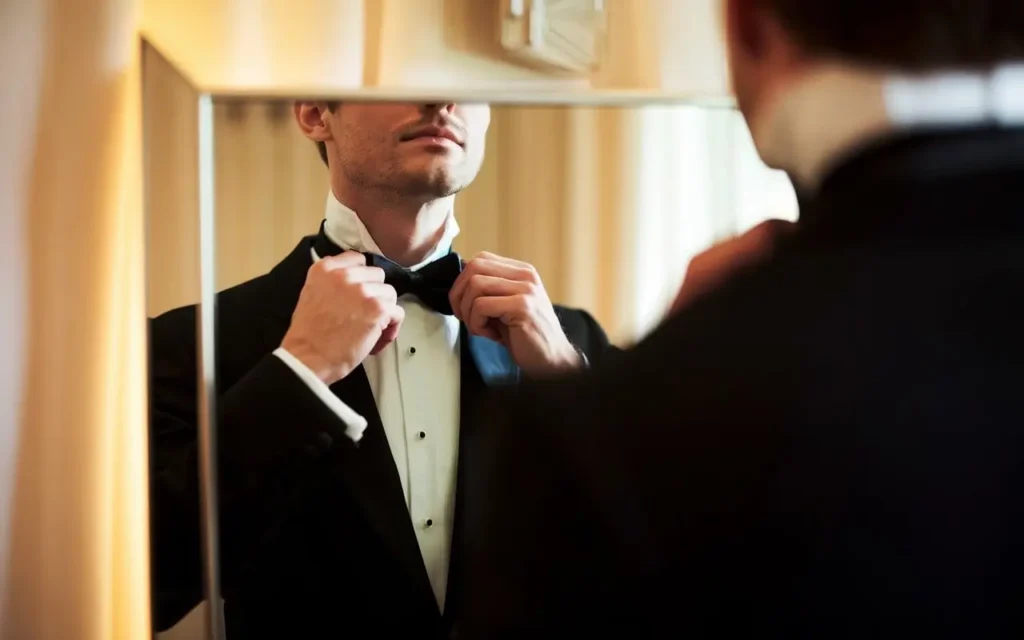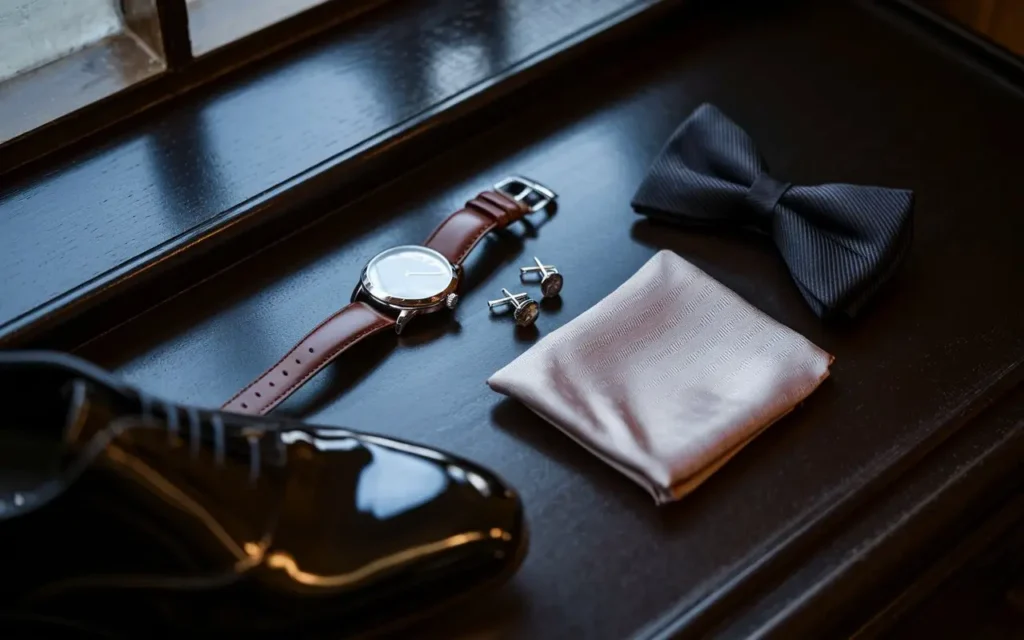Dressing for Special Occasions: A Man’s Guide to Formal Wear
You’ve just opened that crisp envelope. Inside, an invitation to your college buddy’s wedding. As excitement builds, a familiar worry creeps in: “What am I going to wear?”
Don’t sweat it. Whether it’s a wedding, a gala, or a fancy work event, this guide will help you look your best no matter what the event. We’ll cover everything from decoding dress codes to putting together the perfect outfit. By the end, you’ll be ready to tackle any special occasion with style and confidence. So, let’s get started.
Contents
Understanding Dress Codes
First things first: what exactly does that dress code on the invitation mean? Let’s break it down.
Black Tie
This is about as formal as it gets for most of us. Black tie calls for:
- A black tuxedo
- White dress shirt
- Black bow tie
- Black patent leather shoes
White Tie
Even fancier than black tie, white tie is rare these days. If you ever get invited to a state dinner, here’s what you’ll need:
- Black tailcoat
- White waistcoat
- White bow tie
- Patent leather shoes
Creative Black Tie
This is a black tie’s fun cousin. Stick to the black tie basics, but add a pop of personality:
- Colorful bow tie or cummerbund
- Patterned jacket
- Unique cufflinks
Semi-Formal
The most flexible dress code.
For evening events:
- Dark suit
- Dress shirt
- Tie (optional)
For daytime:
- Light-colored suit
- Dress shirt
- Optional tie
Business Formal
Similar to semi-formal attire, but with a more conservative bent:
- Dark suit
- White or light-colored dress shirt
- Conservative tie
- Oxford shoes
Essential Formal Wear Pieces
Now that we’ve covered dress codes, let’s talk about the building blocks of a great formal outfit.

Suits
A well-fitted suit is your best friend for most special occasions. Navy and charcoal are versatile choices that’ll serve you well. For a reliable option, try the Cooper & Nelson Men’s Suit.
Tuxedos
For black tie events, nothing beats a classic tux. Remember, the key differences between a tux and a suit are the satin details – lapels, buttons, and a stripe down the pant leg.
Dress Shirts
White is always a safe bet, but don’t be afraid to experiment with light colors or subtle patterns for less formal events. This Van Heusen Men’s Dress Shirt is a great staple.
Neckwear
Bow ties for black tie, neckties for everything else. When in doubt, a solid dark tie is always classy. For a quality option, check out this KOOELLE Men’s Solid Color Tie.
Vests/Waistcoats
These add a touch of elegance to any outfit. They’re optional for most events, but required for white tie.
Dress Shoes
Oxfords are the gold standard for formal footwear. For a black tie, go with patent leather. These Florsheim Oxford Dress Shoes are a great all-rounder.
Accessories
Cufflinks, pocket squares, and watches can elevate your look. Just remember: less is often more.

Choosing the Right Fit
Here’s a secret: fit is more important than brand or price. A $200 suit that fits perfectly will look better than a $2000 suit that doesn’t.
Key areas to focus on:
- Shoulders: The seam should sit right at the edge of your shoulder.
- Chest: You should be able to button the jacket without it pulling.
- Waist: The jacket should taper slightly at your midsection.
- Length: The jacket should just cover your rear, and the sleeves should show about half an inch of shirt cuff.
Off-the-rack suits rarely fit perfectly. Budget for alterations – they’re worth it. For those special occasions where you want to shine, consider made-to-measure or bespoke suits. Yes, they’re pricier, but they’ll fit like a glove.
Color and Fabric Selection
For formal events, you can’t go wrong with classic colors:
- Navy
- Charcoal
- Black (for the most formal occasions)
In terms of fabric, wool is your best bet. It’s versatile, breathable, and holds its shape well. For summer events, consider lighter fabrics like cotton or linen blends.
When it comes to patterns, solid colors are safest for formal events. If you want to add some interest, try subtle textures or barely-there patterns like pinstripes.
Putting It All Together
Now, let’s talk about coordinating your outfit.
Shirt and Tie Pairings
The classic white shirt works with any tie. For colored shirts, choose a tie that’s darker than the shirt. Patterns can work too – just make sure they’re different scales (e.g., wide stripes on the tie, narrow stripes on the shirt).
Matching Belts and Shoes
Keep it simple: match your leathers. Brown shoes? Brown belt. Black shoes? You guessed it, black belt.
Sock Selection
For formal events, your socks should match your pants, not your shoes. This creates a continuous line from your waist to your feet. If you’re feeling bold, have fun with patterns – just make sure they’re not visible when you’re standing.
Grooming and Final Touches
Looking sharp isn’t just about the clothes. Here are some grooming tips:
Hairstyles: Keep it neat and conservative for formal events. If you’re due for a trim, get it a week before the event so it has time to settle.
Facial Hair: Whether you’re clean-shaven or rocking a full beard, make sure it’s well-groomed. Invest in a good trimmer like the Philips Norelco Multigroom Trimmer.
Cologne: Less is more. One or two spritzes are plenty. Apply to pulse points like your wrists and neck.
Before you head out, do a final check:
- Is everything buttoned and zipped?
- Are your shoes shined?
- Is your tie straight?
- Do you have everything you need (wallet, phone, keys)?
Common Mistakes to Avoid
Even stylish guys can slip up sometimes. Here are some pitfalls to watch out for:
- Ill-fitting clothes: We’ve said it before, but it bears repeating. Fit is king.
- Overdressing or underdressing: When in doubt, ask the host for clarification on the dress code.
- Neglecting shoe care: Scuffed or dirty shoes can ruin an otherwise perfect outfit. Invest in a good shine kit.
- Forgetting climate considerations: Wool might not be the best choice for an outdoor summer wedding.
- Overaccessorizing: Choose one or two key pieces, like a watch and cufflinks. Don’t go overboard.
Budget-Friendly Options
Looking great doesn’t have to break the bank. Here are some tips for the budget-conscious:
Invest in Versatile Pieces
A good navy or charcoal suit can work for most occasions. Add different shirts, ties, and accessories to change up the look.
Consider Rentals
For rare occasions like black tie events, renting can be a smart option. Just make sure to get fitted properly.
Sale Shopping
End-of-season sales can be gold mines for formal wear. Remember, classic styles don’t change much from year to year.
The Bottom Line
Dressing for special occasions doesn’t have to be stressful. With these guidelines in mind, you’ll be ready to tackle any event with style and confidence. Remember, the most important thing is to feel comfortable and confident in what you’re wearing. After all, clothes are meant to enhance your presence, not overshadow it.
FAQ
1. Can I wear a dark suit instead of a tuxedo to a black-tie event?
While a tuxedo is ideal, a dark suit can work in a pinch. Just make sure it’s your sharpest suit, paired with a white shirt and conservative tie.
2. Are patent leather shoes necessary for formal events?
For black-tie and white-tie events, yes. For other formal occasions, well-polished leather shoes are fine.
3. How can I make my formal wear more personalized?
Small touches can add personality without breaking dress codes. Try unique cufflinks, a subtle pocket square, or fun (but not too wild) socks. Just remember, with formal wear, less is often more.